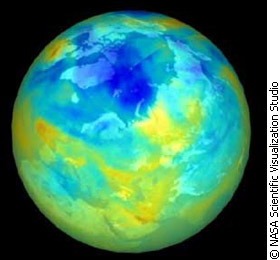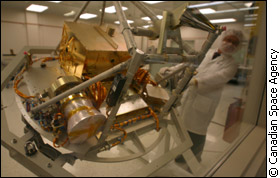On a flickering computer screen, a rainbow of colours lights up an image of the Northern Hemisphere, but these brilliant hues don't paint a pretty picture for Canadians. The image comes from the National Aeronautics and Space Administration's Total Mapping Spectrometer (TOMS), a type of instrument they have been using to monitor ozone since 1978. The colours represent its recorded levels of ozone above the Arctic. In late 1999 and early 2000, NASA observed a total column ozone loss of over 80 Dobson Units above the Arctic. Ozone is measured in Dobson Units. 100 Dobson Units, or 100 DU, is roughly equal to the thickness of one dime. Good ozone levels would measure as a stack of three or four dimes. In 1999 and 2000, parts of the Northern Hemisphere had their stack of dimes robbed, with ozone levels as low as 165 DU. If NASA is right, then the colours on TOMS images will become more alarming. They say that volcanic eruptions and colder Arctic winters could cause a hole to appear in the Arctic ozone layer, as many as five times over the next thirty years. This, just as the Antarctic ozone hole, at the opposite end of the Earth, seems to be showing signs of recovery. Last September, the annually appearing hole split into two sections, and one filled in. In mid-October, the hole covered seven million square kilometres - roughly the size of Australia - down from 21 square kilometres at the same time last year. Research done by Australia's Commonwealth Scientific and Industrial Research Organisation found that levels of chlorine in the atmosphere levelled off in 2000, and for the first time, these levels have started dropping. Along these lines, a recent report put out by the World Meteorological Organization and the United Nations Environment Programme states that ozone levels should be on the rise by the end of this decade. "Models suggest that minimum column ozone occurs prior to 2010 and that recovery to 1980 levels may be expected in the middle of the current century," the report says. On the Canadian front, Environment Canada has said it expects ozone recovery by 2050, if all countries comply with the 1987 Montreal Protocol, which eliminates the use of ozone-depleting substances. Together, these could suggest the smaller Antarctic ozone hole is a sign of recovery. NASA, however, does not see it that way. In a press release issued last September, NASA researcher Paul Newman credited warmer-than-normal temperatures around the edge of Antarctica's stratospheric polar vortex for the hole's split and smaller size. NASA also stressed there is no conclusive data to prove the hole is recovering, and that one year's pattern does not make a long-term trend. North, south, and global warming One Canadian scientist sees this year's Antarctic event as important, even if NASA does not. "I don't think anything like the vortex break-up has been seen in 20 years of watching the ozone in the Southern Hemisphere," says Tom McElroy, a senior scientist with Environment Canada. McElroy says that this year's Antarctic activity may not be a simple matter of recovery or non-recovery. "The change in large-scale weather patterns may mean that the large-scale global circulation is responding to global warming," he explains. "The other concern is that global warming - the increase of carbon dioxide particularly - will cause the Arctic stratosphere to cool in the long term, and in the Southern Hemisphere as well."
Global warming may offset some of the ozone recovery that has been a result of the Montreal Protocol changes, he says. While global warming causes temperatures to rise at the Earth's surface, it has the opposite effect in the stratosphere, where the ozone layer is found. Because extremely cold temperatures in the stratosphere are needed for ozone-depleting chlorine to form, global warming is a hindrance to ozone levels. This could mean that a certain amount of ozone depletion is already in the pipeline, due to greenhouse gas emissions. "It may get worse if the greenhouse gases are important in the thing, as we think they are," McElroy says. "But our best guess right now, given the changes to date, is that the recovery will just be delayed, not actually stopped." The real question for Canadians, though, is the state of the Arctic's ozone layer. On this matter, McElroy disagrees with NASA. "It doesn't seem to be declining based on recent data," he says, but cautions that short-term observations are not always reliable. "I would have thought that we might have seen an indication of recovery by now if cooling wasn't delaying it," he says. "The jury is out." Canada, up in the air While the Arctic situation remains cloudy, a new Canadian satellite might give scientists a clearer picture of what to expect.
This July, the Canadian Space Agency will launch SCISAT-1, the first Canadian scientific satellite in over 30 years. Its mission is the Atmospheric Chemistry Experiment, which will help scientists measure and understand what controls ozone distribution in Earth's atmosphere. "Ozone science is very much Canadian, because of the amplified effects at mid- and high- latitudes," says Réjean Michaud, an atmospheric scientist with the Canadian Space Agency. "It was, and still is felt that all-Canadian scientific satellites would offer Canada greater flexibility in defining the science objectives of the missions," he says. Canadian surveillance of stratospheric ozone dates back to the 1920s, and regular monitoring of ozone over Canada began in the 1950s. Ozone measuring is usually done by ozonesondes, which are packages of instruments launched from the ground by balloons, to measure ozone concentrations at different altitudes. They have been launched from Resolute Bay since 1966. SCISAT-1 will carry two instruments to study the atmosphere: a Fourier Transform Spectrometer (ACE-FTS), and the Measurements of Aerosol Extinction in the Stratosphere and Troposphere Retrieved by Occulation instrument (MAESTRO).
MAESTRO is a spectrophotometer, which uses 2,048 different detectors to measure amounts of atmospheric chemicals. It works by measuring light directly from the sun, then comparing it with light that has passed through the atmosphere. This lets it analyze what chemicals exist at different spots in Earth's atmosphere. ACE-FTS measures atmospheric gases as the sun's rays pass through them. It uses solar occulation to measure temperature, trace gases, thin clouds, and aerosols in the atmosphere. To make these measurements, it needs SCISAT-1 to be pointed at Earth's horizon during sunrise and sunset. These instruments are what set the satellite apart from others, Michaud explains. "SCISAT-1 will be the only one using the solar occulation technique, which will provide precise measurements of an exhaustive suite of trace gases... related to ozone depletion," he says. He adds that the satellite will be complementary to some monitoring tools already in orbit, and others that will be launched soon. While Canadians wait Canadians have a lot to lose from an Arctic ozone hole. Ozone loss there could mean more exposure to harmful ultraviolet rays for populated parts of Canada. Health effects linked with ozone depletion include skin cancer, cataracts, and harm to the body's immune system. As satellites are launched and data is analyzed, there may something that Canada, and other parts of the world, can do to prevent Arctic ozone depletion. For a country with Kyoto on its mind, McElroy has one suggestion. "If we are right, and there is a climate change component in the polar ozone depletion story, implementing carbon dioxide reduction programs would help," he says. Would this be a definite help? That's not certain, but neither is the state of the ozone layer, at either of the Earth's poles. Right now, all anyone knows for sure is there's a lot up there, which scientists down here have yet to figure out.
|
|
| Canadian Space Agency Web site for SCISAT-1 |


